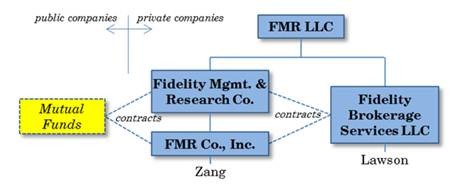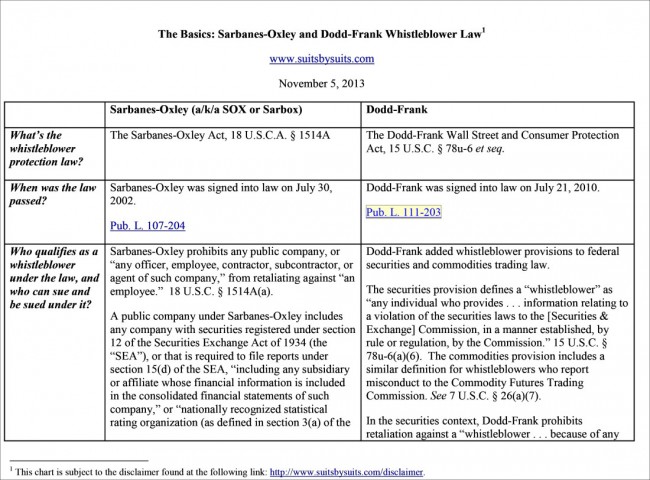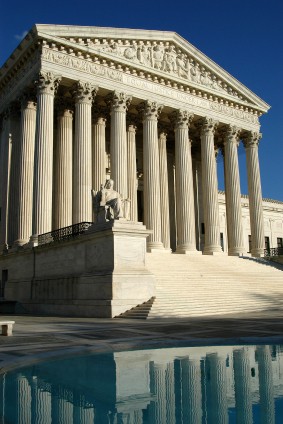Show posts for: Sarbanes-Oxley Act
-
Read more
On Tuesday, the Supreme Court issued an opinion that may have sweeping implications for whistleblowers and employers. In Lawson v. FMR LLC, the Court decided that the anti-retaliation provision of the Sarbanes-Oxley Act of 2002 (18 U.S.C. § 1514A) allows an employee to bring a claim even if that employee works for a private contractor or subcontractor of a public company. The Court’s decision could lead to a wide range of Sarbanes-Oxley lawsuits by outside counsel, private accountants, cleaning services, and others.
Lawson was a split decision. Justice Ginsburg, joined by Chief Justice Roberts, Justice Breyer, and Justice Kagan, and by Justices Scalia and Thomas “in principal part,” wrote for the majority. Justice Scalia wrote a separate concurrence, joined by Justice Thomas. And in an unusual grouping, Justice Sotomayor authored the dissent, joined by Chief Justice Roberts and Justice Alito. Today, we'll tackle Justice Ginsburg's opinion; tomorrow, we'll take a look at what Justices Scalia and Sotomayor had to say.
But first, a little background.
-
Read more
For those of us who follow whistleblower law, Wednesday was a big day – and a good one for employers. In two separate federal appellate decisions, courts affirmed the dismissal of whistleblower actions based on very different issues. For potential whistleblowers and employers alike, the decisions demonstrate yet again the importance of the particular requirements and scope of the law that a whistleblower relies on to support his claim.
The first decision, Villanueva v. Department of Labor, No. 12-60122 (5th Cir. Feb. 12, 2014), comes to us from the Fifth Circuit. It involves William Villanueva, a Colombian national who worked for a Colombian affiliate of Core Labs, a Netherlands company whose stock is publicly traded in the U.S. Villanueva claimed that he blew the whistle on a transfer-pricing scheme by his employer to reduce its Colombian tax burden, and that his employer passed him over for a pay raise and fired him in retaliation for his whistleblowing.
-
Read more
On December 10, 2013, Suits by Suits contributing editors Ellen D. Marcus and Jason M. Knott will present a live webinar titled “Whistleblower Watch: Big Issues in the Latest Whistleblower Cases Under Dodd-Frank, Sarbanes-Oxley, and the Internal Revenue Code.” During the webinar, Ms. Marcus and Mr. Knott will discuss the whistleblower and anti-retaliation provisions of the Dodd-Frank and Sarbanes-Oxley Acts, the Internal Revenue Code, and other federal statutes. Their presentation will address the types of businesses and conduct that can be targeted by whistleblowers, the procedures that whistleblowers must follow to pursue and preserve a claim, the remedies available to whistleblowers, and more. Ms. Marcus and Mr. Knott will also examine the pressing issues under these laws that are being debated in the courts. This includes contradictory decisions about whether the Sarbanes-Oxley Act’s whistleblower provision covers employees of privately-held companies, such as investment advisers—an issue that is currently before the U.S. Supreme Court in the case of Lawson v. FMR LLC, which we have previously covered in various posts. To register for the webinar, click here.
-
Read more
On Tuesday, the Supreme Court heard oral argument in Lawson v. FMR LLC. As we explained in this post, Lawson presents the question of whether Sarbanes-Oxley’s whistleblower anti-retaliation provision (Section 806 of Sarbanes-Oxley, codified at 18 U.S.C. § 1514A) shields employees of privately-held contractors of public companies such as the plaintiffs, who are employees of investment advisers for Fidelity mutual funds. We editors of Suits by Suits don’t often get the chance to report live on the cases we cover, but an argument at One First Street was too tempting to pass up, even on a blustery Washington day. Here are five major takeaways that we drew from the argument (with the caveat that reading the tea leaves from an oral argument is always a difficult proposition):
1. The Court is uncomfortable with the scope of potential Sarbanes-Oxley claims that would result from the Fidelity employees’ interpretation of the statute.
A number of Justices pressed Eric Schnapper, who argued for the Fidelity employees, and Nicole Saharsky, arguing for the United States in support of the employees, as to how the Court could limit the reach of the statute if it holds that Sarbanes-Oxley allows employees of private companies to bring whistleblower retaliation claims. Justice Breyer posed a hypothetical involving an employee of a privately-held gardening company who reports on mail fraud by his employer, is fired, and then brings a whistleblower anti-retaliation claim, arguing that he is covered by Sarbanes-Oxley because his company has gardening contracts with public companies. Schnapper argued that the statute as written would cover the gardener, but the Justices were less convinced that Congress intended this kind of reach for Sarbanes-Oxley. Justice Breyer even commented that the fear of expanding the statute to cover “any fraud by any gardener, any cook, anybody that had one employee in the entire United States” was the “strongest argument” against the Fidelity employees’ position.
-
 Read more
Read moreOn Tuesday, November 12, the Supreme Court will hear argument in the most-watched case of this Term (at least for those of us who edit this blog). The case, Lawson v. FMR LLC, presents the question of whether an employee of a privately-held contractor of a public company can bring a whistleblower retaliation claim against his or her employer under the Sarbanes-Oxley Act of 2002. The plaintiffs in the case, and the parties who have appealed to the Supreme Court, are Jackie Lawson and Jonathan Zang.
In their lawsuit, Lawson and Zang claim that their employers – a group of privately-owned Fidelity subsidiaries that serve as “investment advisers” to publicly-held Fidelity mutual funds – retaliated against them for raising concerns about fraud. Here’s a handy chart from Fidelity’s brief that illustrates the relationship between the parties:
The First Circuit dismissed Lawson and Zang's claims, holding that Sarbanes-Oxley’s anti-retaliation provision only protects employees of public companies. Because Lawson and Zang worked on the blue side of the chart, and not the yellow side, they couldn’t bring a claim for retaliation. (The mutual funds on the yellow side have no employees; they do their business through their contractors on the blue side.)
What do Lawson and Zang argue?
The parties spend a lot of time parsing the language of the Sarbanes-Oxley anti-retaliation provision (18 U.S.C. § 1514A). In their opening and reply briefs, Lawson and Zang argue that the plain text of the law shows that Congress intended to shield employees of contractors of public companies from retaliation for reporting corporate misconduct. If Congress didn’t mean to protect those employees, they say, it wouldn’t have prohibited retaliation by “any officer, employee, contractor, subcontractor, or agent” of “such [public] company.” Under Fidelity’s reading of this provision, the language about contractors would only come into play if a contractor retaliated against a public company employee, and because that doesn’t happen in the real world, the use of the term “contractor [or] subcontractor” would be meaningless.
-
 Read more
Read moreThe Dodd-Frank and Sarbanes-Oxley whistleblower laws are hot topics right now. A split of authority is developing in the federal courts over how an employee can qualify as a whistleblower and bring a retaliation claim under Dodd-Frank. And the Supreme Court will hear argument next Tuesday in a case, Lawson v. FMR LLC, that will require it to decide whether private employers can be subject to Sarbanes-Oxley retaliation claims by their employees.
As we at Suits by Suits continue to watch these issues, we thought it would be helpful to step back for a broader view of these important whistleblower laws. In the table linked here, we have summarized the important facets of each law. This table will serve as a reference point for new developments, placing them in the broader context of these whistleblower protections.
-
 Read more
Read moreAs we’ve covered here and here, the Supreme Court will decide this term whether a whistleblower can pursue a Sarbanes-Oxley claim for retaliation by a privately-owned employer. Jackie Lawson and Jonathan Zang, former employees of Fidelity investment advisory companies, say yes. The First Circuit said no.
Lawson and Zang have now filed their opening brief in their attempt to persuade the Supreme Court to disagree with the First Circuit and reinstate their claim. And they have even included a non-gratuitous George Clooney reference. (Hat tip to scotusblog.com for making this and numerous other Supreme Court resources available.)
Lawson and Zang’s argument involves the interpretation of 18 U.S.C. § 1514A, the provision of Sarbanes-Oxley that allows whistleblower claims. They argue that the plain language of Section 1514A applies to protect not only employees of publicly traded companies and mutual funds, but also employees of contractors of those companies, such as the Fidelity investment advisers at issue in their case. The statute bars contractors from retaliating against an “employee”: Lawson and Zang contend that this should be read to refer to those contractors’ “own employees,” in addition to the employees of public companies with whom the contractors work. Br. at 15. They argue that it wouldn’t make any sense to only prohibit retaliation by contractors against others’ employees, since it would be very difficult, if not impossible, for a contractor to terminate someone else’s employee. Br. at 22.
-
 Read more
Read more2013 has been a banner year for followers of the Sarbanes-Oxley whistleblower protection provision, 18 U.S.C. § 1514A. As we’ve previously discussed on Suits by Suits, the Supreme Court will decide in its next term whether Sarbanes-Oxley protects employees of privately-owned corporations, in Lawson v. FMR, LLC. The Third Circuit also recently held, in Wiest v. Lynch, that an employee does not have to allege that he “definitively and specifically” reported a known legal violation in order to state a Sarbanes-Oxley claim.
Most recently, on Tuesday, the Tenth Circuit held that an employee is protected under Sarbanes-Oxley for reporting misconduct even when the misconduct does not involve a fraud against shareholders (Lockheed Martin Corp. v. Administrative Review Board, Department of Labor).
The facts of Lockheed involve tawdry letters, military affairs, and humiliation in the workplace.
-
 Read more
Read moreYesterday, the Supreme Court announced that it will hear the case of Jackie Hosang Lawson and Jonathan Zang, two former Fidelity employees who seek to reverse the dismissal of their Sarbanes-Oxley whistleblower claims. In this post last week on Suits by Suits, we outlined Lawson and Zang’s petition to the Court and described the long odds that petitioners face when they ask the Supreme Court to review their cases. The U.S. government also didn’t do Lawson and Zang any favors when it told the Court that it shouldn’t take their case. Now that Lawson and Zang have bucked the odds, they might be feeling like they bought that lucky PowerBall ticket.
The Court has outlined the question presented by Lawson and Zang’s case as follows:
Section 806 of the Sarbanes-Oxley Act, 18 U.S.C. § 1514A, forbids a publicly traded company, a mutual fund, or “any ... contractor [or] subcontractor ... of such company [to] ... discriminate against an employee in the terms and conditions of employment because of” certain protected activity. (Emphasis added). The First Circuit held that under section 1514A such contractors and subcontractors, if privately-held, may retaliate against their own employees, and are prohibited only from retaliating against employees of the public companies with which they work.
. . .
Is an employee of a privately-held contractor or subcontractor of a public company protected from retaliation by section 1514A?
To prevail, Lawson and Zang must convince the Court that the answer is yes.
-
 Read more
Read moreOnly a handful of employment cases make it all the way to the Supreme Court’s august chambers at One First Street. That’s largely because the Court has discretion whether or not to review cases decided by lower courts of appeals. Thousands of unhappy litigants file petitions for writ of certiorari every year, asking for review from the highest court in the land. Almost all are turned away.
Tomorrow, the Court will consider whether to accept an appeal by Jonathan Zang and Jackie Lawson in a case that has significant implications for the Sarbanes-Oxley whistleblower protection provision, 18 U.S.C. § 1514A. Section 1514A, which was passed as a response to the Enron and other financial scandals of the early 2000s, prohibits public companies, as well as “any other officer, employee, contractor, subcontractor, or agent of such company,” from retaliating against “an employee” for protected activity. The issue in Zang and Lawson’s case is whether Section 1514A protects employees of privately-held companies, if those companies are working as contractors for public companies.
As the regulatory and business environments in which our clients operate grow increasingly complex, we identify and offer perspectives on significant legal developments affecting businesses, organizations, and individuals. Each post aims to address timely issues and trends by evaluating impactful decisions, sharing observations of key enforcement changes, or distilling best practices drawn from experience. InsightZS also features personal interest pieces about the impact of our legal work in our communities and about associate life at Zuckerman Spaeder.
Information provided on InsightZS should not be considered legal advice and expressed views are those of the authors alone. Readers should seek specific legal guidance before acting in any particular circumstance.
Contributing Editors

John J. Connolly
Partner
Email | +1 410.949.1149

Andrew N. Goldfarb
Partner
Email | +1 202.778.1822

Sara Alpert Lawson
Partner
Email | +1 410.949.1181

Nicholas M. DiCarlo
Associate
Email | +1 202.778.1835




